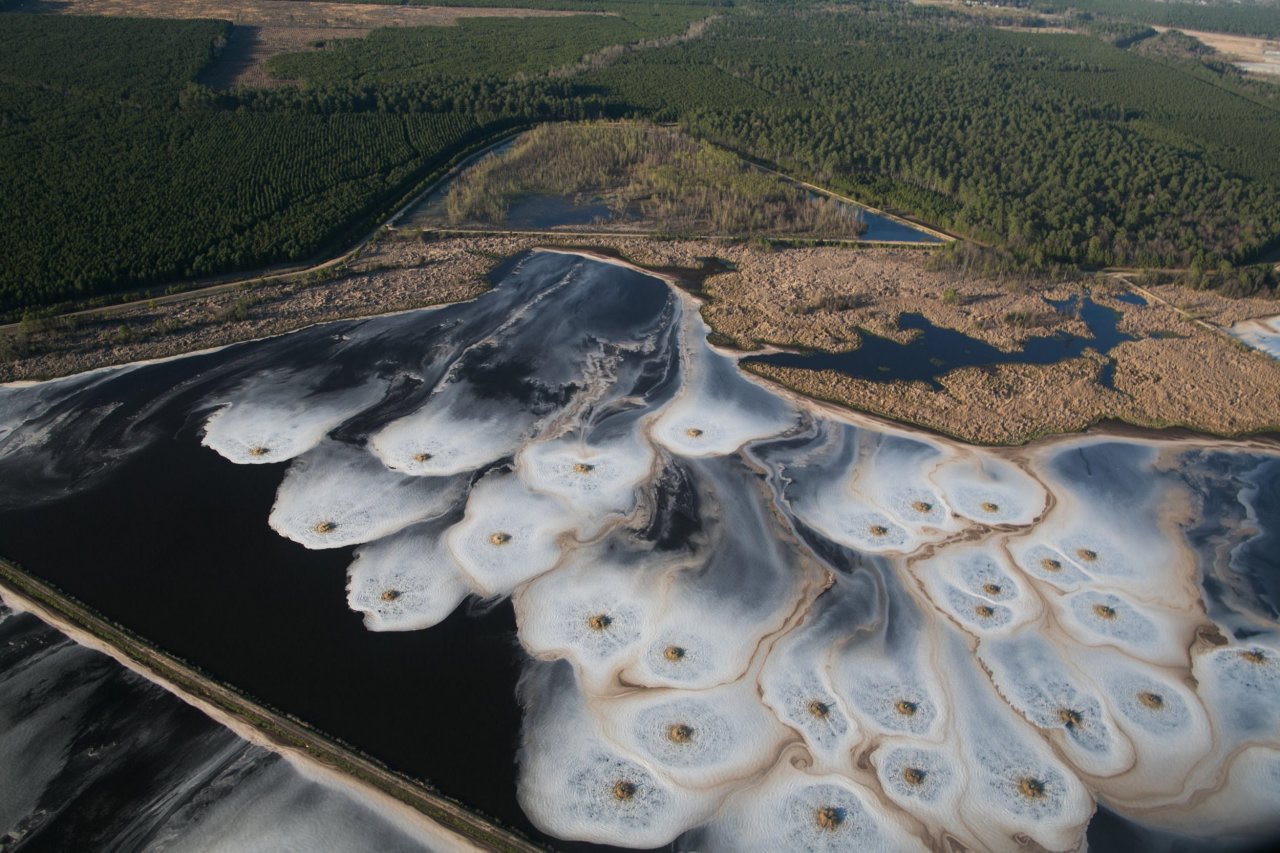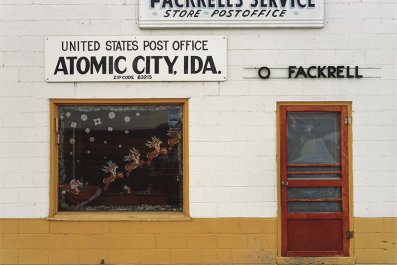"Let me give you a sketch of the neighborhood," Leroy Patton said as he put his car in Park on the side of Lawson Road. He took his toothpick out of his mouth and used it to point to an empty house, an abandoned doll lying facedown in the weeds in front of the hollow structure. The Lawson couple used to live here, Patton says; the street was named for them. "They're dead from cancer and stroke."
He pointed to another property. "Down here is Pat. Her parents died from cancer back there, and now her husband sick too." He turned to a long driveway lined with trees and junk cars. "And this here is my place. Ain't nobody but me and my old lady left. Everybody dead in my family but me. All of 'em from cancer."
The Patton family has lived on Lawson Road in Crossett, Arkansas, for three generations. Like most of the town, the Pattons earned their living from the nearby lumber and paper mill. In 1962, when Patton was 20, Georgia-Pacific, a fast-growing lumber and paper products company, bought the mill and turned it into a paper, chemical and plywood plant. Production soared. Patton watched the mill prosper and bring prosperity to his town—1,200 jobs, $6.7 million in annual tax revenue, a zoo, a 3-D printer for the library. But he also watched, one by one, his parents, neighbors and high school friends die.
Less than a mile away, Penn Road tells a similar story. In 15 homes, 11 people have died from cancer. "Look there," Patton said as he stood on Penn Road, pointing to the permanent cloud that hangs above the Georgia-Pacific plant. "Look how close to the plant you are here." The plant runs 24 hours a day, 365 days a year, and emits upwards of 1.5 million pounds of toxic chemicals every year, according to the U.S. Environmental Protection Agency's (EPA) Toxic Release Inventory, which is based on self-reported calculations from emitting facilities. In the case of the Georgia-Pacific plant, these emissions include known carcinogens such as formaldehyde, dioxin, acetaldehyde and chloroform.

The plant also emits a steady stream of another toxin, hydrogen sulfide, both in the air and in the effluent streams of its water treatment system. One of these streams, which residents call "Stink Creek," runs through the back of Patton's land. When the wind is blowing the wrong way, it brings a harsh, metallic smell into the homes of nearby residents. A strong whiff stings the nose and burns the throat and lungs.
Residents began complaining about emissions back in the 1990s. In addition to the worrisome odors, there were the chemicals eating through air-conditioning units and copper wiring. Georgia-Pacific responded by going door to door, doling out checks in exchange for signed release forms absolving the company of any responsibility for damages to the residents' property—or their health. "There was this man who was coming around talking to different people about the damages on their houses, coming around analyzing the property," Patton said. "He came out with a checkbook, said he was gonna write a check. I ran him off."
Others signed: Marion and Lila Thurman from Thurman Road received $158,000. David and Barbara Bouie from Penn Road received $34,000. In exchange, they agreed to absolve Georgia-Pacific of "any and all past, present, or future, known and unknown, foreseen and unforeseen bodily and personal injuries or death."
Asked about these release forms, Georgia-Pacific says they were issued in response to allegations of property damage. The wording about personal injuries and death was nothing more than "standard legal practice" and did not reflect the possibility that the plant might be responsible for residents' illnesses.
The Smelly River
The Ouachita River begins at Lake Ouachita in central Arkansas, where it is a vibrant blue. But by the time it reaches Monroe, Louisiana, about 50 miles after it passes by the Georgia-Pacific plant, it's a dark coffee color. "Most of the people in Monroe and West Monroe do not know that the river is the wrong color, because it's the only color they've ever seen," says Cheryl Slavant. "But it is. It's the wrong color. I can remember when our river was blue and beautiful."
Slavant can also remember sitting on the levee as a child and watching the water-ski shows on the river. Her husband recalls fishing there and frying up his catch for supper. But in the late 1950s, the river began to change. It's not just that the water turned brown. The local department of health warned residents to limit the quantities of fish from the river that they were eating because of high levels of mercury. There are no more water-skiing contests because residents are afraid to swim in that water. On some days, residents say, the river puts off a foul stench.
In 2007, Slavant launched Ouachita Riverkeeper, a group working to clean and protect the Ouachita River through community organizing. Slavant and her volunteer river patrolmen had just begun investigating the cause of the pollution in 2009 when she received a call from Crossett. Residents there had heard about her work on the local news. They said they knew what was turning the river brown and believed it was making them all sick. So Slavant met with a group of residents, among them Patton and the Bouies, and helped them form an organization, the Crossett Concerned Citizens for Environmental Justice, which grew rapidly. At one point, Slavant counted over 700 members—over 10 percent of the town's population. At their meetings, she heard stories about Stink Creek and how it carried discharge from the plant, through the town, to the treatment basins and, eventually, into the Ouachita River.
Georgia-Pacific says its water treatment system is thorough, carefully monitored and in full compliance with the law according to parameters laid out in the permit given to it by the Arkansas Department for Environmental Quality (ADEQ). The company also says the body of water residents call Stink Creek is a lawful, necessary part of that process. Barry Sulkin, an environmental scientist with the Public Employees for Environmental Responsibility, or PEER, disagrees. Stink Creek, he says, is not supposed to be a water treatment canal. It's actually a stream called Coffee Creek, a naturally occurring body of water that predates the plant—and is protected by the federal Clean Water Act.

The United States Geological Survey has been mapping the region since 1934, three years before the plant started producing paper and decades before Georgia-Pacific acquired the mill. The earliest maps show Coffee Creek beginning inside where the Georgia-Pacific complex would eventually stand and running down into Mossy Lake before continuing on into the Ouachita River; later maps show the creek beginning inside the complex. The Clean Water Act, passed in 1972, requires that any pollutants discharged into bodies of water be clean enough so as to not disrupt the activities in those waters, such as fishing, drinking and supporting animal life. The law gives state regulators, such as ADEQ, the power to determine what those activities are and what the limits on pollutants should be. In this case, ADEQ determined that Coffee Creek and the lake through which it flows, Mossy Lake, do not have any "fishable/swimmable or domestic water supply uses."
But in a 2007 Use Attainability Analysis (UAA) published by the EPA, the agency found that, "aside from the fish and macroinvertebrate communities using Coffee Creek and Mossy Lake, other wildlife live in or frequently contact the [Georgia-Pacific] effluent. Muskrat, beaver, nutria, turtles and ducks are known to use Coffee Creek and Mossy Lake, sometimes in very large numbers." Most important, it concluded that "the waters of Coffee Creek and Mossy Lake have the potential to support aquatic life indicative of streams in the ecoregion."
Those findings might have seriously affected the parameters of Georgia-Pacific's permit—had ADEQ been required to consider them. But the company sent a letter to the EPA (cc'ing several Arkansas and Louisiana congressmen and senators) in which it accused the regulatory agency of acting without its knowledge and demanding the opportunity to redo the study using a contractor of its choosing. The EPA agreed, the 2007 UAA was set aside, and Georgia-Pacific's effluent flowed on. Meanwhile, Georgia-Pacific hired the environmental engineering company Aquaeter to conduct a study. It completed a draft UAA in 2013 but has not yet finalized or published any findings.
Slavant says it all comes down to politics. The EPA gets its funding from Congress, and members of Congress get their funding from businesses. Members of Congress also answer to their constituents, and those constituents want jobs. Georgia-Pacific provides southern Arkansas with 1,200 of them, and no one—not the state of Arkansas, nor its representatives, nor the residents of Crossett—can afford to put those jobs in jeopardy.
For Tim Toler, president of the Crossett Chamber of Commerce, those jobs are more than just jobs; they're Crossett's lifeblood. "Those jobs provide an excellent standard of living in our town, they provide retirement for people...and they provide health care for employees," he says. "And, of course, those jobs provide an income that allows people to shop in our town, eat in our restaurants and purchase services and goods. Our town would not exist [without the mill]." Which is why, while many citizens are deeply concerned that the plant's emissions might be making them sick, the townsfolk are far from sharpening their pitchforks. On the contrary, most residents are fiercely protective of the plant and quick to shoot down the possibility that it could be harming them.
Ben Walsh, a Crossett family practitioner, rejects claims that Crossett suffers from any abnormal health problems. "We have to look at the science, and the science says there's no increased rate of cancer in Ashley County," Walsh says. He's right. The Arkansas Department of Health cancer registry shows the rate of cancer deaths in the county to be slightly below the state average. So what does Walsh make of places like Penn or Lawson Road? "You would want to look at all the variables, such as whether these people smoked or were obese," he says.
Or you might want to look at how close they are to the wastewater stream, Slavant says. The numbers of affected people clustered in the area are just too improbable for her to consider any other possible cause. And it's hard for her to get Georgia-Pacific's release forms out of her mind, with the wording "past, present, or future...personal injuries or death."
Chemist and environmental consultant Wilma Subra is certain emissions are to blame for the town's many respiratory illnesses. In 2012, the Louisiana Environmental Action Network commissioned Subra to set up air-monitoring stations all around town to sample levels of hydrogen sulfide. At the same time, she asked resident to fill out symptom reports recording instances of dizziness, headaches, coughing or eye irritation. She found that hydrogen sulfide levels were highest nearest the stream and that higher levels corresponded with greater and more severe symptoms among residents.
In addition to the chemicals Georgia-Pacific reports, there could be any number of unreported chemicals leaching into the atmosphere "off the books." On an inspection last year, the EPA observed several defective pieces of equipment that were allowing unidentified gases to escape into the atmosphere. It also observed filtrate tanks and storage tanks that were knowingly being vented into the atmosphere rather than through a controlled system, as required by the Clean Air Act. Altogether, the EPA found 33 areas where Georgia-Pacific was noncompliant with federal laws and dozens of other "areas of concern."
Georgia-Pacific is working on addressing the EPA's concerns, says Jennifer King, a public affairs manager with Georgia-Pacific. In the meantime, however, the plant continues to operate around the clock.
Georgia-Pacific's permit is up for renewal, and if enough concerned citizens submit comments to ADEQ, it could be pressured to modify the permit this time around. "The state has to open the draft permit up for public comment," says Corinne Van Dalen, Ouachita Riverkeeper's lead attorney. "And if there are enough public comments, they will have to hold a hearing to discuss the permit…. After that, even if the permit is approved, anyone can appeal a permit decision to the permit appeals board and from there to the state court."
Slavant isn't looking for Georgia-Pacific to close up shop; she only wants to see regulatory agencies hold the plant to the standards of the law. "There needs to be a GP plant here, but it needs to be updated, it needs to be fixed," she says. "And it can be done."



















